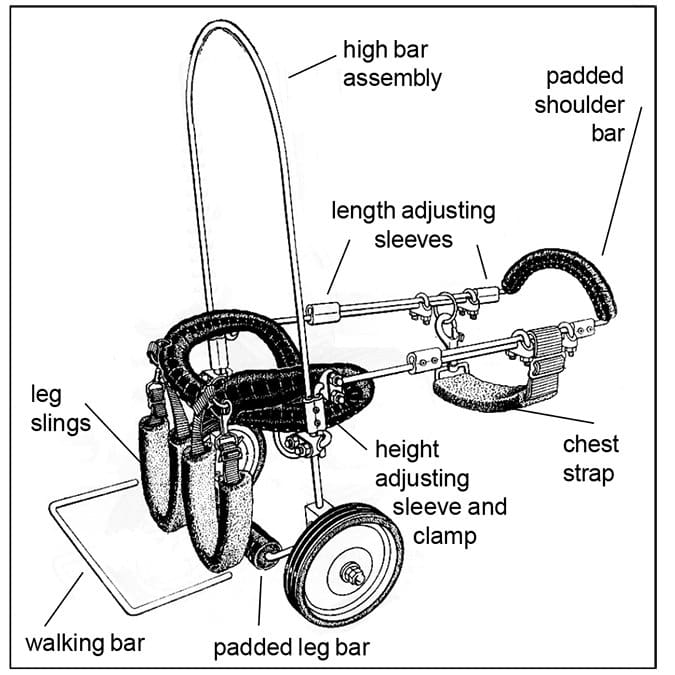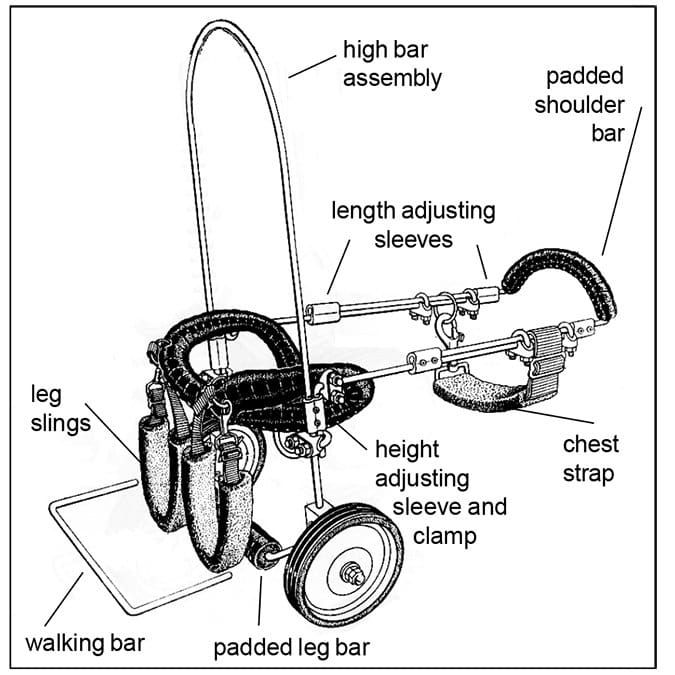Nita was a standout among her littermates, clearly the most vivacious of a lively bunch. Her owner, Lyn Dodd, still chuckles at the thought of her favorite dog, a happy companion in her customary shotgun seat, riding around in Dodd’s pickup truck.
“She traveled with me everywhere, on long hikes in the woods, on planes on the seat next to me, we went everywhere together,” remembers Dodd. “I don’t have children; she was like my kid!”

It wasn’t until Nita was 14 1/2 years old that she began having health problems. “One day I noticed that Nita was sitting in an odd way. Her hind leg looked funny the way it sprawled out to one side, her rump rolled under. I also noticed that she was not putting weight on one foot; that leg seemed weaker than the other,” Dodd describes.
Because of her advanced age, and because it was winter, Dodd thought her little dog must be suffering from arthritis, especially since she also had a slight limp in the morning that went away as the day warmed up. Her veterinarian agreed, and prescribed some herbal remedies for arthritis.
At about this time, Dodd moved to Bend, Oregon, which at 3400 feet elevation, has a dry climate, which is thought to ease arthritis pain. Nita’s limp, however, grew progressively worse. “It seemed as though she was losing feeling in the leg,” Lyn recounted, “yet, her skin, coat, eyes, and teeth looked as good as ever, her attitude was really good, and she never indicated that she was in any kind of pain.” As time went by, Nita’s condition developed into a full-blown mystery.
Dodd took Nita to several veterinarians, but none were able to definitively diagnose Nita’s problem. One doctor suggested that Nita suffered from a herniated disc, yet could not recommend surgery to repair the disc, due to the potential of paralysis as a result of the surgery. Dodd took Nita to an animal chiropractor for therapy, but no lasting change was evident following several spinal adjustments.
The diagnostic breakthrough came as a result of a visit to the Veterinary Referral Clinic in Portland, Oregon. Following the most complete physical examination and history Dodd had ever seen performed on a dog, as well as extensive urinalysis, serum chemistry and blood panels, the ultimate diagnosis was Cushing’s Syndrome, which was contributing to the general deterioration of Nita’s spinal column.
This Syndrome, also known as hyperadrenocorticism (HAC), is caused by excessive amounts of cortisol in the bloodstream. The majority of naturally occurring HAC cases have too much cortisol being secreted by the adrenal cortex due to a tumor in the pituitary gland at the base of the brain. Fewer dogs have excessive cortisol levels due to tumors in an adrenal gland, several of which are located next to the kidneys. Cases can also be caused by overzealous or long-term administration of cortisol-containing medications. (Some of these include certain skin creams, eye drops, and ear medications.) HAC is more common in some breeds, notably, in Boxers, Poodles, Dachshunds, and Terriers, though any breed can be affected. It is also more commonly diagnosed in middle-aged and older dogs, since the onset of symptoms is so gradual that owners often don’t notice the changes resulting from increased cortisol production, or they may confuse the symptoms with those of the normal aging process.
Classic symptoms of HAC include excessive thirst and hunger, elevation of liver enzymes, hair loss on the dog’s trunk, and a pendulous, distended abdomen. (The bloated look can be caused by a thinning of the skin, weakening of muscles, and enlarging of the liver.) Rarely, but occasionally, muscle dysfunction and weakness are manifested by a stiff gait.
But Nita hadn’t been exhibiting any of the classic symptoms. Her skin and hair always looked great, and she only gained weight gradually as she became more sedentary. It took time, and a combination of veterinarians and tests to diagnose the pituitary-triggered type of Cushing’s.
What to Do for a Paralyzed Dog
Predictably, there are a multitude of treatments for such a complex illness, and Dodd directed her veterinarians to administer all the ones she felt would help the little dog, omitting those with the biggest risks to her health.
With pituitary-dependent Cushing’s, the current treatment of choice among allopathic veterinarians is a drug called O.p’-DDD, or Lysodren, which destroys the adrenal gland, followed by administration of cortisone and prednisolone to replace vital cortisol function. Nita tolerated this treatment quite well, eating and drinking perhaps just a little more than usual, yet remaining regular and continent as always. The treatment effectively stopped the progression of the Cushing’s Syndrome, though it couldn’t reverse the damage done to Nita’s spine.
The diagnosticians at the Veterinary Referral Clinic also performed a myelogram, a picture of the spinal column nerves achieved through dye injection and radiographs. The myelogram revealed a general deterioration of Nita’s spinal column, but no compressions or lesions that could be improved with surgery.
To augment the best of what traditional medicine had to offer, Dodd tried an array of non-traditional therapies to treat her terrier’s spinal problems. She used several herbal supplements, and found magnetic field therapy (which uses weak, pulsing magnetic fields to stimulate healing biological reactions) to be useful, though she had to curtail this treatment due to the long drive to the therapist. “You could see Nita felt and walked better right away after each treatment,” Dodd described, “but as the months rolled into winter, the 3 1/2-hour drive each way over mountain passes twice a week was becoming more dangerous with snowy roads, and the treatment results were not as long-lasting as we had hoped.”
The Right Option for Nita
Another year and a half passed as Dodd sought out and implemented every beneficial therapy she could find. As a result of all these ministrations, Nita’s attitude and energy level was great, and her teeth, eyes and coat looked terrific – and yet her hind end kept getting worse. As the plucky little dog’s mobility decreased, so she had to drag herself around the house and yard, Dodd increasingly felt pressured to end Nita’s struggle and put her to sleep. But given her deep connection with the dog, and due to Nita’s own optimistic outlook, Dodd couldn’t bring herself to call it quits. Instead, she kept looking for help for Nita.
“Nita helped me survive some very hard times in my life – a divorce and then a bout with cancer; it was the least I could do to give her a good quality of life in her old age. For all the love and companionship she’d given me, I was not ready to give up on her yet,” said Dodd.
Since all of Nita’s functions, save mobility, were working well, Dodd started talking out loud about inventing a cart for her companion’s hind end. Then an acquaintance mentioned she had already seen such a device, and gave Dodd the name of the company: K-9 Carts. Dodd located and called the company immediately.

Cruising in Her Cart
Dodd found the people at the K-9 Cart Company, located in Big Sky, Montana, very helpful. They immediately sent her a packet of information about their carts for paraplegic dogs and cats, and when it arrived, Dodd was impressed with the illustrations and operating instructions for the carts. Their representative gave Dodd detailed instructions on how to precisely measure Nita for a cart, and she sent in an order.
When it arrived, Dodd followed the instructions for the cart’s use, putting Nita in the device for just a few minutes each session, gradually building up length of time the terrier spent in the cart. Nita took to the rig right away, and quickly exhibited a new lease on life!
“At first, the time she spent in the cart was like therapeutic rehabilitation, with Nita’s rear legs gaining strength from her time in the cart, a little more each day,” Dodd described. “But soon, Evil Knieval had nothing on Nita! My neighbor built a ramp over the front steps of my house, and Nita would fly in and out and around the house.”
The worst hazard Dodd encountered with the cart was when Nita would seem to forget she was in the cart, and she would bang into a doorway or getting stuck when she tried to walk under an ottoman. Dodd would flinch when Nita would occasionally launch off the steps, competing with Dodd’s other dogs to chase a ball or a squirrel, but Nita was unstoppable. Once again Dodd could take Nita on long, enjoyable walks in the woods along with the other dogs. If the elderly dog grew tired on a long walk, Dodd would sometimes take her out of the cart and carry her in a special backpack, letting her rest. She says Nita would “let me know she was ready to go again by wiggling around in the pack; I’d let her out and then off she’d go again in the cart!”
A Wonderful Last Year
Finally, however, at age 17 1/2, Nita began suffering more paralysis. As time passed, her impairment extended from the rear to her front legs. Eventually, she was unable to use the cart. Nita didn’t exhibit signs of pain, but her eyes seemed to seek Lyn out, telling her it was time. Dodd arranged to have her favorite veterinarian put Nita to sleep while she rested in one of her favorite places.
Dodd still mourns her brave, big-hearted little dog, and frets from time to time that there might have been even more she could have done for her in her final years. But she is especially pleased that, thanks to the K-9 Cart, Nita’s last year was happy and full. She remains an enthusiastic advocate of the device, and says she would recommend a cart to anyone whose dog needed help getting around. Dodd says firmly, “I’m positive that the joy Nita felt extended her life a little longer, not to mention gave the end of her life a quality she would not have had otherwise during her last year.”
K-9 Carts range in price from $190 (Dachsund size) to $380 (giant breeds) plus shipping. Susan Eskew, a freelance writer living in Crested Butte, Colorado, is a frequent contributor to WDJ.





